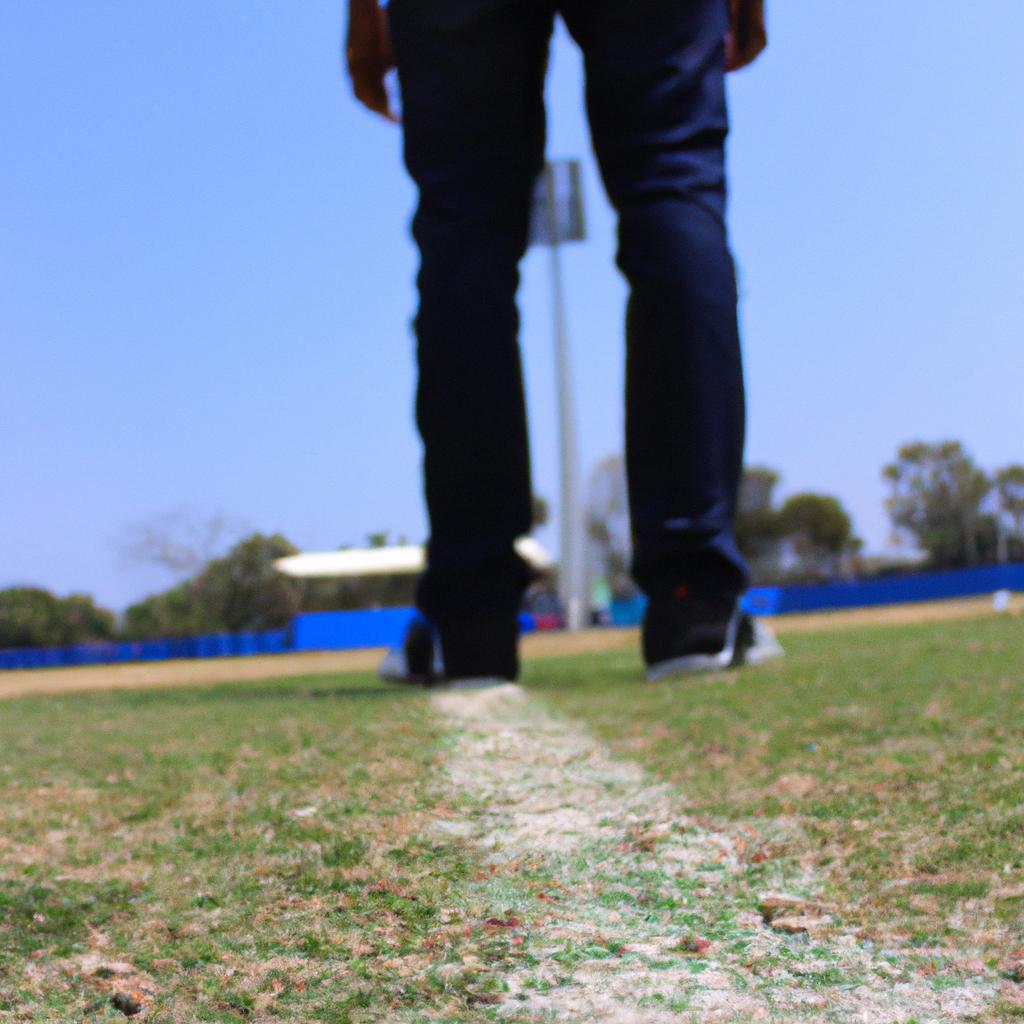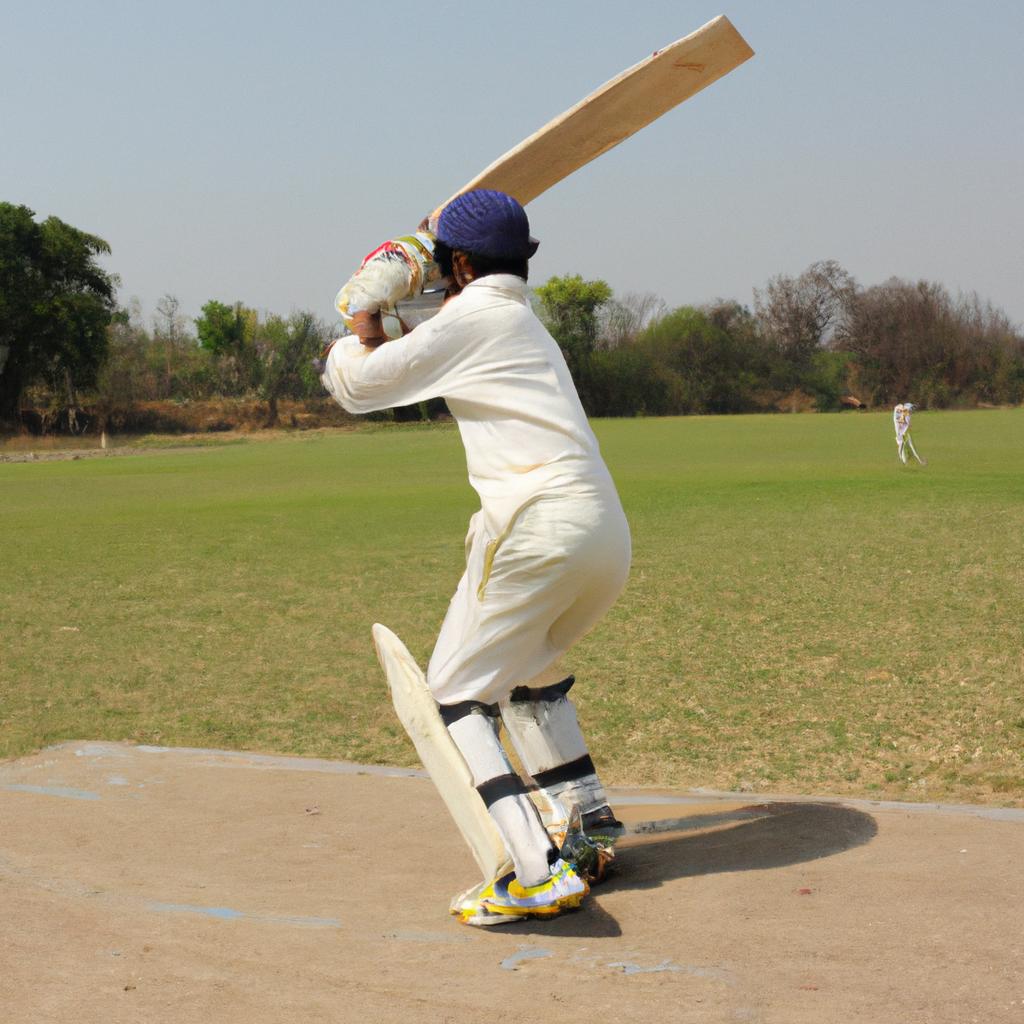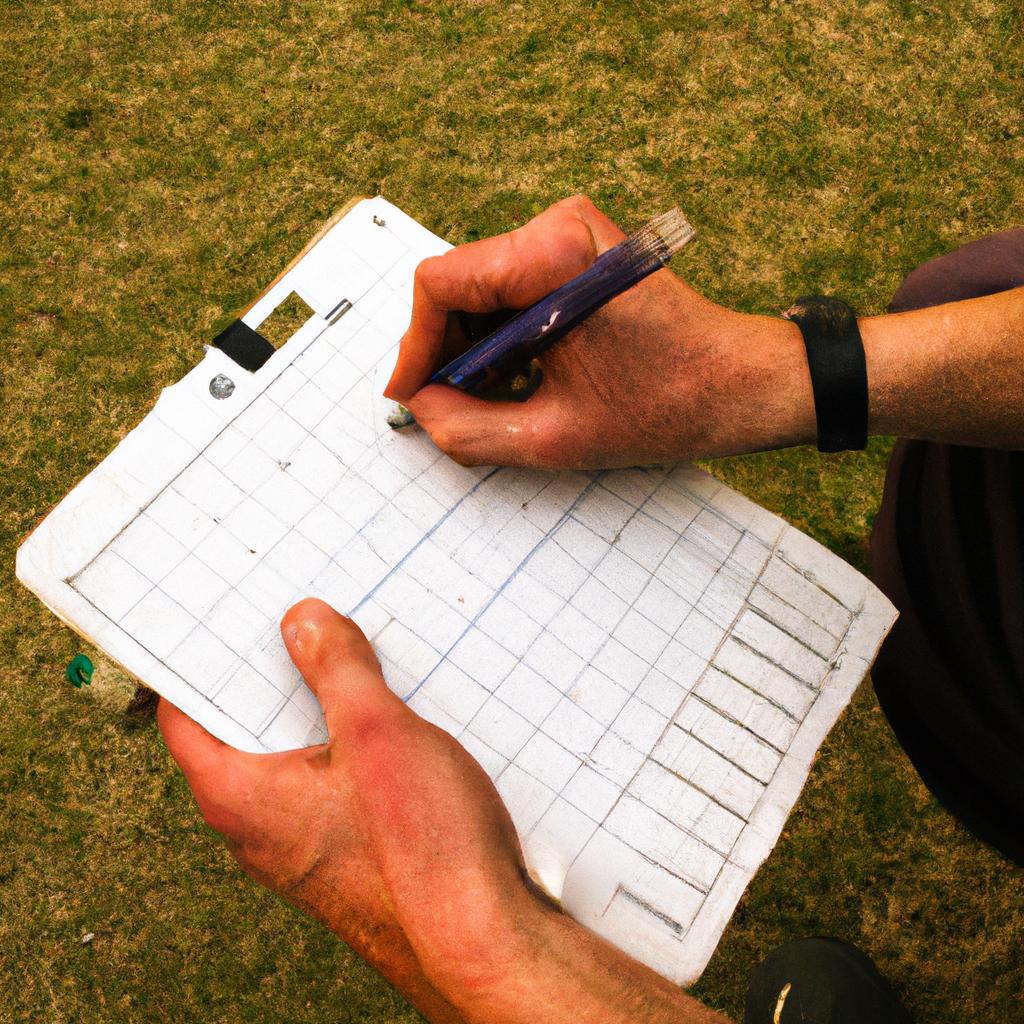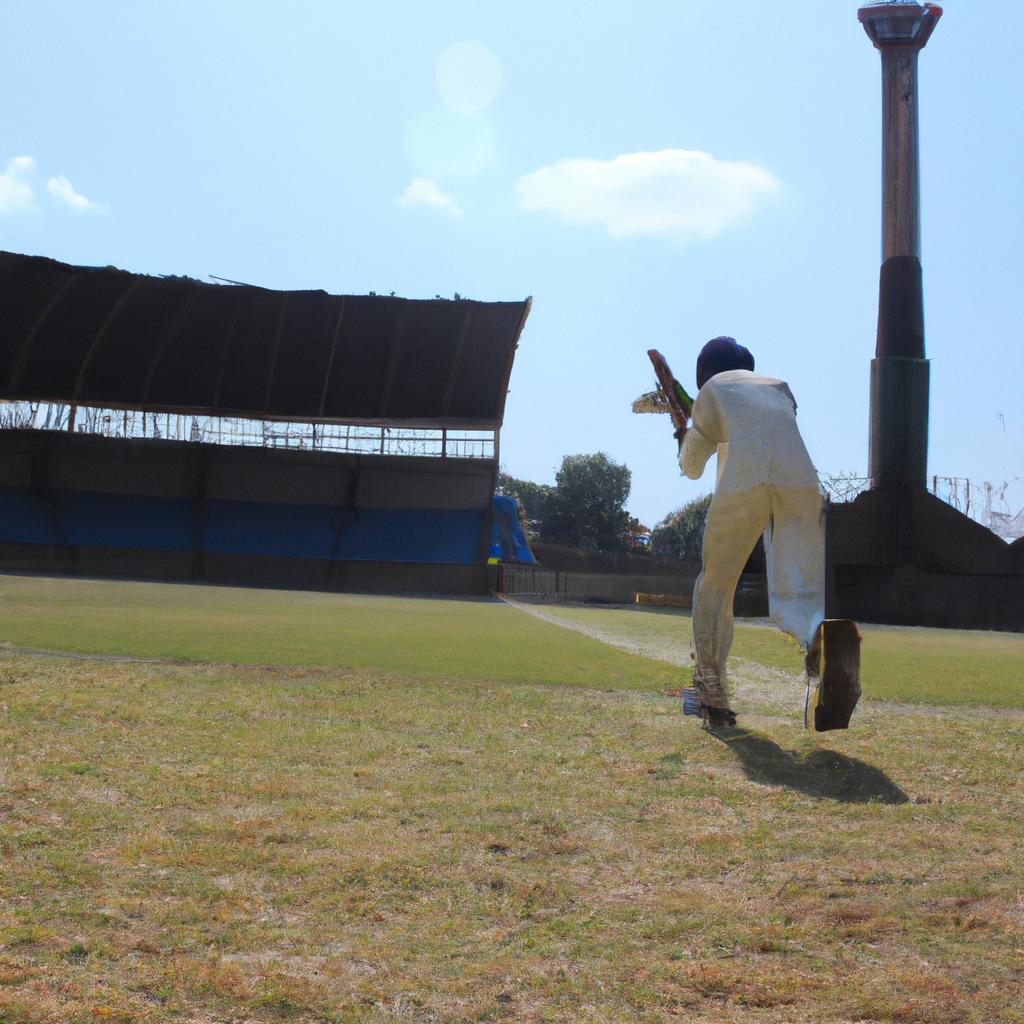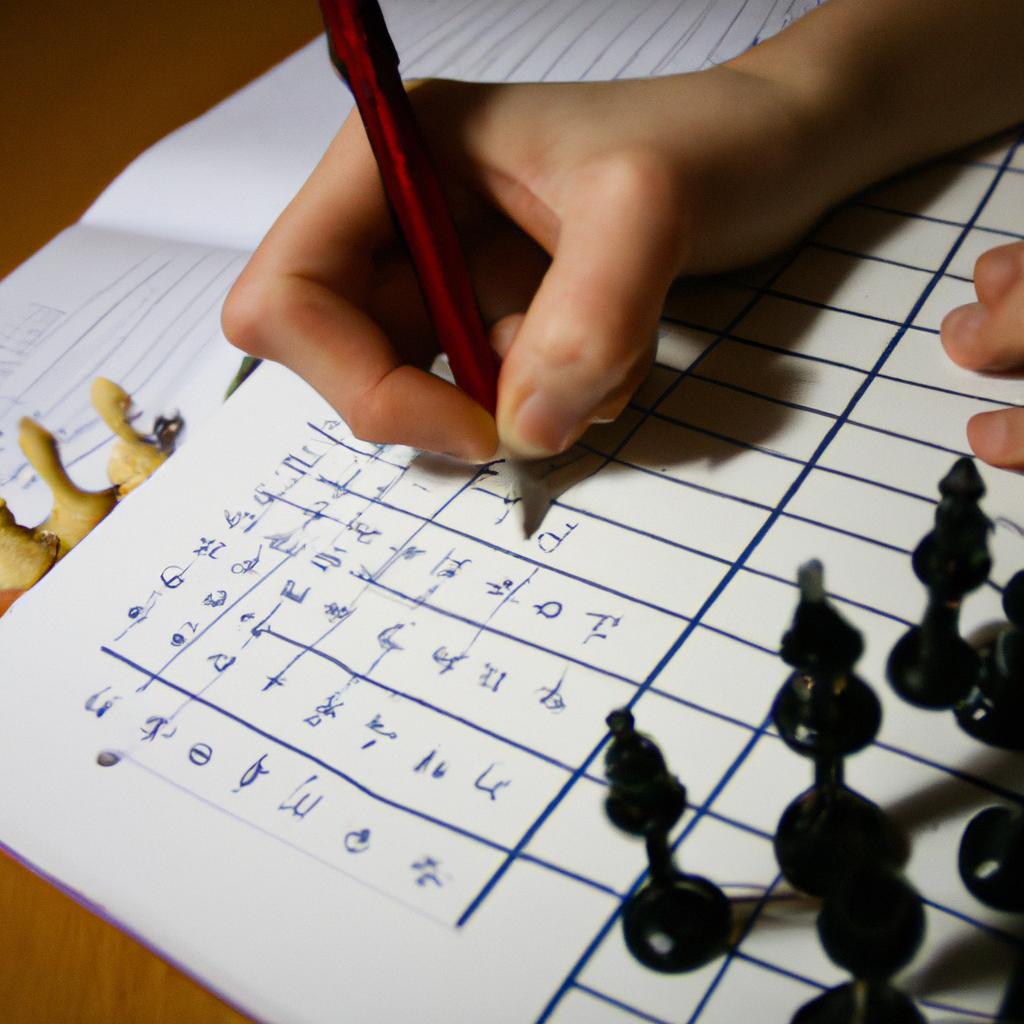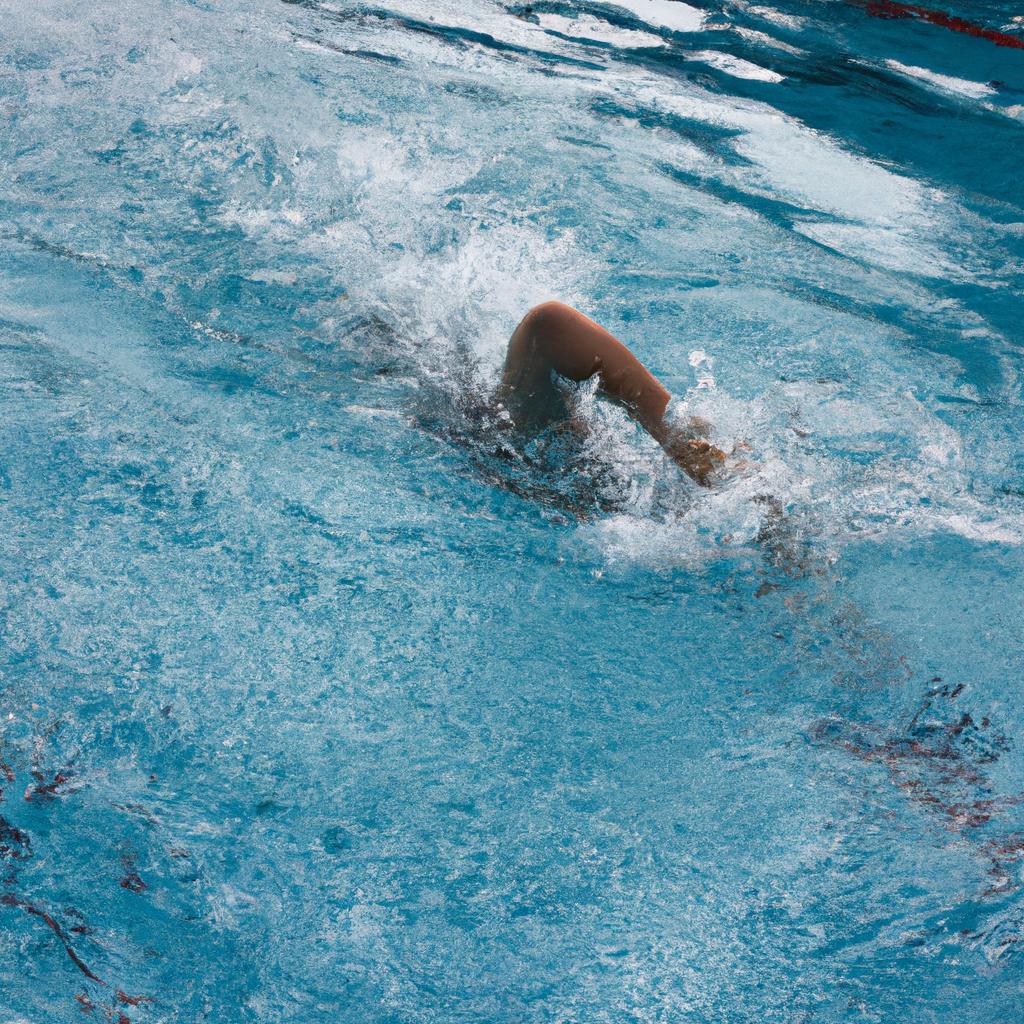Field positions in cricket play a crucial role in the strategic positioning of players on the field. Each position is strategically placed to maximize defensive and offensive capabilities, creating an intricate web of coordination and anticipation. For instance, imagine a hypothetical scenario where a batsman with exceptional power and precision has just entered the crease. The fielding team would need to carefully consider their placement of players to counteract this formidable opponent. In this article, we will provide an overview of various field positions in cricket, exploring their purposes, responsibilities, and tactical significance.
Understanding the different field positions requires delving into the intricacies of cricket’s playing area. The field is divided into several regions, each designated for specific roles within the game. As such, both batting and bowling teams employ astute strategies when deciding on their respective placements. Fielders are positioned mainly behind or around the pitch to optimize coverage for possible shots by the batsmen. It is through these calculated placements that teams aim to thwart scoring opportunities while also seeking wicket-taking chances. By examining key fielding positions such as slips, gully, cover point, deep square leg, mid-off, mid-on, fine leg, third man, backward point, and long-on among others; we can gain insight into the tactical objectives and defensive capabilities of each position.
-
Slips: Slip fielders are positioned behind the batsman’s wicket on either side, usually in a crouched position. Their primary objective is to catch an edge off the bat if the ball deviates from its intended path.
-
Gully: Located to the side of slips, gully fielders are responsible for catching edges that may not carry to the slip region. They are also well-positioned to stop hard-hit shots through this gap.
-
Cover Point: Positioned towards the off-side, cover point aims to prevent runs by stopping shots hit square or backward of point. This position requires quick reflexes and agility.
-
Deep Square Leg: Situated on the boundary line on the leg side, deep square leg covers a large area and is responsible for stopping powerful shots played in that direction.
-
Mid-off: Positioned straight ahead and slightly towards the off-side, mid-off helps restrict runs by attacking drives played in front of them.
-
Mid-on: Similar to mid-off but located on the leg side, mid-on prevents scoring opportunities from shots played straight or slightly towards the leg-side.
-
Fine Leg: Positioned near the boundary line at a 45-degree angle behind square leg, fine leg fields mainly against hooks or pulls aimed towards that region.
-
Third Man: Located behind square on the off-side boundary, third man stops edges or intentional glides that evade other fielders.
-
Backward Point: Placed behind point but closer to square than cover point, backward point aims to stop cuts or late-cuts played behind square on the off-side.
-
Long-on: Positioned near the boundary line straight ahead of mid-on, long-on primarily focuses on preventing big hits down that region while also cutting off running between wickets.
Each fielding position has its specific role within a team’s strategy. However, it’s important to note that field placements can vary depending on the style of play, condition of the pitch, and strengths/weaknesses of both teams. By carefully selecting and positioning fielders, a team can maximize their chances of taking wickets, restricting runs, and ultimately gaining a strategic advantage in the game of cricket.
Batsman
One of the key positions in cricket is that of a batsman. A batsman’s primary objective is to score runs for their team by hitting the ball and running between the wickets. To illustrate the role of a batsman, let’s consider an example scenario: In a crucial match, Team A requires 10 runs to win off the final over with one wicket remaining. The pressure is on the batsman as he faces each delivery, knowing that any mistake could cost his team victory.
When it comes to field placements for a batsman, teams strategically position their players around the field to maximize their chances of taking wickets or restricting scoring opportunities. Here are four common fielding positions that can create challenges for a batsman:
- Slip: Fielders positioned close to the batsman on either side behind him, ready to catch an edge if the ball deviates after being hit.
- Gully: Located slightly wider than slip, gully aims to catch edges from shots played square of the wicket.
- Mid-wicket: Positioned towards mid-on from square leg, this position prevents easy boundary hits when playing across-the-line shots.
- Cover point: Stationed on or near the off-side boundary line and covers drives played through extra cover region.
To further understand these field placements, refer to Table 1 below:
| Position | Description |
|---|---|
| Slip | Closest catching position behind the batsman |
| Gully | Slightly wider than slip |
| Mid-wicket | Between square leg and mid-on |
| Cover point | Near off-side boundary |
In summary, being a successful batsman in cricket involves not only mastering various batting techniques but also understanding how different field placements can affect gameplay. By employing strategic positioning and utilizing various tactics against opposition bowlers, skilled batsmen can make significant contributions to their team’s success.
Moving on, let’s explore the role of a bowler and how they impact the game.
Bowler
Having discussed the role of a batsman in cricket, we now turn our attention to another crucial position on the field – the bowler. The bowler is responsible for delivering the ball towards the batsman with precision and strategy.
Paragraph 1:
To illustrate the importance of a skilled bowler, let us consider an example from a hypothetical match between two teams. Team A has a fast bowler known for his lightning-quick deliveries, while Team B has a spinner renowned for his ability to deceive batsmen with subtle variations in flight and spin. In this scenario, both teams rely heavily on their respective bowlers’ expertise to gain an advantage over their opponents.
Paragraph 2:
In order to execute their bowling strategies effectively, different fielding positions are strategically placed around the ground. These positions aim to maximize opportunities for wicket-taking or restricting runs. Here are some key fielding positions commonly observed in cricket:
- Slips: Positioned behind the wicketkeeper at an angle, slips are close-catching positions used primarily against pace bowlers.
- Mid-on/Mid-off: Located straight down the pitch on either side of the wicket, these positions provide cover and support during batting strokes played directly along or slightly off-center.
- Deep square leg/Fine leg: Situated near or beyond the boundary line behind square leg or fine leg, respectively, these positions guard against shots played across or down leg-side by right-handed batsmen.
- Point/Cover: Placed on opposite sides of each other but still within catching range, point and cover provide coverage for drives hit through that area.
The presence of well-placed fielders creates anticipation and excitement among players and spectators alike:
- Fielders diving full stretch to take stunning catches
- Quick reflexes stopping powerful shots from reaching boundaries
- Strategic positioning leading to run-saving interceptions
- Teamwork and coordination exhibited through seamless communication between fielders
Emotional table:
| Fielding Position | Key Responsibilities | Skills Required |
|---|---|---|
| Slips | Catch balls which edge off the bat | Excellent reflexes |
| Mid-on/Mid-off | Support bowler during straight shots | Quick footwork |
| Deep square leg/ Fine leg | Guard against leg-side shots | Speed and agility |
| Point/Cover | Cover drives played in that area | Good anticipation |
Paragraph 3:
The role of the bowler, supported by well-positioned fielders, is crucial in determining the outcome of a cricket match. By skillfully utilizing their expertise and capitalizing on strategic placements, bowlers can create pressure on batsmen, leading to wickets or restricted scoring opportunities. Each fielding position serves a specific purpose, contributing to the overall defensive strategy employed by the team.
Understanding the importance of coordinated fielding tactics brings us to another key position – the wicket-keeper. This vital player ensures a smooth transition from bowling to batting while also keeping an eye out for potential dismissals behind the stumps.
Wicket-keeper
Field Positions in Cricket: An Overview
Previously, we explored the role of the bowler in cricket. Now, let’s shift our focus to another crucial position on the field – the wicket-keeper. To illustrate the importance of this role, consider a hypothetical scenario where the opposing team is chasing down a high target score. The wicket-keeper plays a pivotal role in maintaining team morale and ensuring effective communication among players.
The wicket-keeper stands behind the stumps and has multiple responsibilities that require great skill and agility. Firstly, they are responsible for collecting deliveries from the bowlers and attempting to dismiss batsmen by catching balls or executing stumpings when they venture out of their crease. Secondly, they need to anticipate potential opportunities for run-outs by quickly retrieving any loose balls that may have been missed by other fielders. Lastly, the wicket-keeper acts as an anchor point for field placements, providing valuable input based on their observation of batsmen’s strengths and weaknesses.
To better understand this position, let us delve into some key aspects associated with being a wicket-keeper:
- Reflexes: A proficient wicket-keeper must possess lightning-fast reflexes to react swiftly when facing unpredictable ball trajectories or sudden changes in direction after pitching.
- Hand-eye coordination: Successfully taking catches requires excellent hand-eye coordination, allowing them to grasp moving objects accurately under immense pressure.
- Agility: Wicket-keepers often dive or leap towards different angles to make crucial saves or take difficult catches, necessitating exceptional physical agility.
- Communication skills: Effective communication between the wicket-keeper and other players is essential for coordinating strategies during critical stages of play.
Consider how these traits can make or break crucial moments within a match:
| Trait | Impact |
|---|---|
| Quick reflexes | Ensures timely dismissal of batsmen |
| Sharp hand-eye coordination | Increases the likelihood of successful catches and stumpings |
| Agility | Enables exceptional saves and prevents potential boundary runs |
| Strong communication skills | Facilitates improved teamwork and strategic decision-making |
In summary, the wicket-keeper plays a pivotal role in cricket as they are responsible for dismissing batsmen, executing run-outs, and providing valuable insights to shape field placements. Their reflexes, hand-eye coordination, agility, and communication skills all contribute to their effectiveness on the field.
Transitioning seamlessly into our next section, we will now explore the versatile position of an all-rounder in cricket. This player brings a unique combination of batting and bowling abilities, making them invaluable assets to any team’s performance.
All-rounder
Field Positions in Cricket: An Overview
In the previous section, we explored the role of the wicket-keeper. Now, let us delve into another significant field position – the all-rounder. To illustrate the importance and versatility of this position, consider a hypothetical scenario where an all-rounder emerges as a key player during a crucial match by excelling in both batting and bowling.
The all-rounder is known for their ability to contribute effectively with both bat and ball. They possess solid batting skills which allow them to score runs consistently while also having the capability to take wickets through their bowling prowess. This dual talent makes them indispensable assets to any cricket team.
To better understand the role of an all-rounder, here are some key points worth noting:
- All-rounders add depth to a team’s lineup by providing options for both batting and bowling.
- Their presence allows teams to maintain a balance between specialist batsmen and bowlers.
- All-rounders often play a crucial role in turning matches around with their contributions in multiple aspects of the game.
- The success of an all-rounder depends on maintaining consistency across batting and bowling disciplines.
To further grasp the significance of this position, consider the following table showcasing notable examples from cricket history:
| Player | Batting Average | Bowling Average |
|---|---|---|
| Jacques Kallis | 55.37 | 32.65 |
| Shaun Pollock | 32.31 | 23.11 |
| Andrew Flintoff | 31.77 | 32.78 |
| Shakib Al Hasan | 39.40 | 29.85 |
These statistics highlight how these exceptional cricketers have made substantial contributions with both bat and ball throughout their careers.
In summary, all-rounders hold a pivotal position in cricket due to their ability to excel in both batting and bowling. Their presence provides teams with flexibility, balance, and the potential to influence match outcomes significantly. Now, let us explore another crucial field position – that of a fielder.
Transitioning into the subsequent section about “Fielder,” it is important to recognize the impact that these individuals have on the game beyond their batting and bowling abilities.
Fielder
Moving on from the all-rounder, another crucial position in cricket is that of a fielder. Fielding involves players strategically positioned around the ground to stop runs and take catches when the batsman hits the ball. Let’s consider an example to understand the significance of fielders in cricket.
Imagine a scenario where a skilled bowler delivers a fast-paced yorker towards the batsman. The batsman tries to play it defensively but ends up edging the ball towards the slips cordon. It is here that the role of fielders becomes vital – they need to react quickly, anticipate the direction in which the ball will travel, and attempt to catch it before it touches the ground.
Fielders have specific positions assigned based on their specialization and skill set. Here are some key points highlighting their responsibilities:
- Outfielders: Positioned near or beyond the boundary line, outfielders cover larger areas and focus primarily on preventing boundaries.
- Close-in fielders: Located close to the batsman at various positions such as slips, short leg, silly point, etc., these individuals aim to catch any edges or sharply hit balls.
- Wicketkeeper: Stationed behind the stumps, this player has two roles – catching balls missed by both bowlers and batters (byes) and attempting stumpings when a batter leaves their crease.
- Boundary riders: These are fielders who patrol along or within inches of the boundary rope with exceptional agility to prevent shots from crossing over for six runs.
To better illustrate how different fielding positions contribute to team success, consider this table showcasing each role’s primary responsibility:
| Position | Primary Responsibility |
|---|---|
| Slips | Catching potential edges |
| Silly Point | Saving runs off defensive strokes |
| Short Leg | Preventing quick singles through taps |
| Mid-off | Stopping straight drives |
| Deep Fine Leg | Preventing leg side boundaries |
| Long On | Restricting runs over the mid-wicket |
By having fielders strategically placed, cricket teams aim to create pressure on batsmen and reduce their scoring opportunities. Effective fielding can often lead to wickets being taken, turning the tide of a match.
As we delve deeper into the intricacies of cricket positions, let’s now shift our focus to another vital role – that of the captain. The captain plays a pivotal role in decision-making and leading the team towards victory.
Captain
Fielder positions play a crucial role in cricket, as they are responsible for preventing the batsmen from scoring runs and taking catches. Each field position has its own strategic importance, with players strategically placed around the field to maximize their chances of getting wickets or stopping runs.
One example that demonstrates the significance of fielding positions is when a fast bowler is bowling at high speed. In this scenario, having a fielder positioned deep on the boundary can be advantageous, as it allows them to catch balls hit hard by the batsman before they reach the boundary line. This prevents the opposing team from scoring four runs and potentially enables a catch dismissal.
To illustrate further, here is an emotional bullet point list showcasing some common fielding positions:
- Silly Point: Requires exceptional reflexes and bravery due to close proximity to the batsman.
- Deep Mid-Wicket: Positioned towards the boundary line to stop long hits.
- Gully: Ideal for catching edges when spinners are bowling.
- Short Fine Leg: Provides coverage for shots played behind square leg area.
Additionally, a table displaying different fielding positions along with their descriptions can help understand their specific roles better:
| Field Position | Description |
|---|---|
| Slip | Closest to the batter; primarily used for catching off edges |
| Cover | Protects against drives through mid-off region |
| Long On | Positioned farthest away on straight boundaries |
| Third Man | Guards boundaries behind slip cordon |
In summary, understanding various fielding positions in cricket is essential for both players and spectators. The positioning of fielders can heavily influence game outcomes by either restricting runs or providing opportunities for dismissals. By strategically placing individuals across different parts of the playing area, teams aim to control the flow of runs and enhance their chances of securing wickets during matches.

